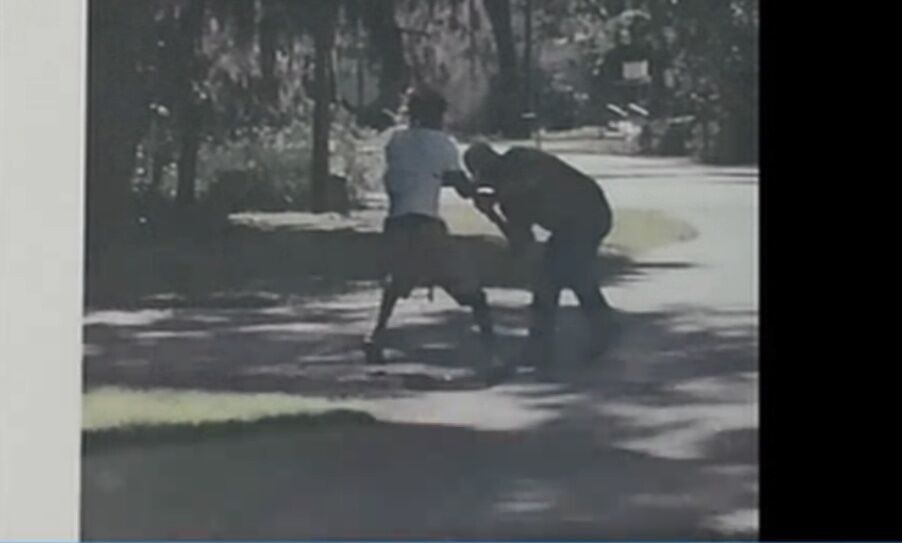Arbery had ‘fight or flight’ reaction in final minutes of life, prosecution rests case
Published 8:44 pm Tuesday, November 16, 2021

- Screenshot from PBS News Hour's live video of the Ahmaud Arbery murder trialAhmaud Arbery and Travis McMichael are seen on video captured from William 'Roddie' Bryan's cell phone fighting over Travis McMichael's gun.
BRUNSWICK — The state rested its case Tuesday in the trial of three white men accused of chasing and killing a Black man in their neighborhood.
Prosecutors on day eight of the trial called to the stand Dr. Edmund Donoghue, the medical examiner who performed the autopsy of Ahmaud Arbery, on Feb 24, 2020, the day after his death.
Travis McMichael, Greg McMichael and William “Roddie” Bryan followed Arbery — who they suspected was responsible for burglaries in the neighborhood — throughout the Satilla Shores neighborhood in Brunswick, Georgia, attempting to perform a citizen’s arrest.
The chase turned tragic when — as seen on a video recorded from Bryan’s cellphone — Arbery and Travis McMichael appear to have engaged in a tussle over Travis McMichael’s shotgun. During the tussle, three gunshots are heard and Arbery later falls dead in the street.
Donoghue said he believes a bullet grazed Arbery’s wrist before entering his chest.
Donoghue said the angle of the shot to Arbery’s wrist to under arm “could be consistent” with someone pushing the shotgun away or trying to grab the gun.
Arbery continued his attempt to take the gun away.
He had a “fight or flight” reaction, Donoghue agreed.
Still, up-close shots of the altercation with Arbery and McMichael shows blood spewing from what appears to be Arbery’s hand.
One of the three bullets missed Arbery but another bullet entered underneath his armpit, which Donoghue said could’ve been that shot that caused Arbery’s death.
When asked by prosecutor Linda Dunikoski if there was anything that first responders could have done to save Arbery if that had been the only shot, Donoghue responded, “I don’t think so.”
An arm gesture made by Arbery as he attempted to run after being shot indicates that Arbery’s arm was paralyzed, Donoghue explained. Following the shots, Arbery has an “unguarded fall” face down to the ground due to loss of consciousness.
Graphic photos were shown of Arbery’s bruised face, gunshot wounds and bloodied clothing.
Robert Rubin, Travis’ attorney, asked Donoghue if he was familiar with the phrase, “When they can no longer flee, they fight.”
“Yes,” Donoghue responded.
However, Rubin said there was nothing preventing Arbery from continuing to run, referencing Donoghue’s previous comments on Arbery’s fit, muscular build.
Georgia Bureau of Investigation agents also testified Tuesday to the routes that Arbery was believed to have traveled during the defendants pursuit of him.
Arbery’s home was less than two miles from the under-construction Satilla Shores home where he was often seen on video surveillance “plundering around.”
The property owner testified that he had never seen Arbery take anything, and the three defendants did not see Arbery break into a home or steal anything the day of his death.
Nearly two weeks before the Arbery’s death, Travis McMichael had called 911 to report seeing a man who looked like Arbery run into the vacant home, telling the operator he believed the man to be armed.
Police arrived and did not locate the man on the property and showed the McMichaels and others on the scene a video surveillance of the man on the property.
Kevin Gough, Bryan’s attorney, is expected to give his opening statements Wednesday and the defense will begin calling its witnesses.
The McMichaels and Bryan are charged with malice murder, felony murder, aggravated assault, false imprisonment and criminal attempt to commit a felony in May 2020.
They are also federally charged with hate crimes — interference with rights and attempted kidnapping, alleging that the trio used force and threats of force to intimidate and interfere with Arbery’s right to use a public street because of his race.


